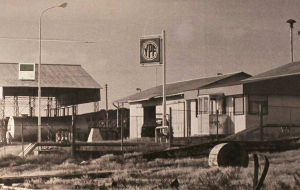MercoPress. South Atlantic News Agency
Fifty years since the air link between Falkland Islands and Comodoro Rivadavia
 The sea plane Grumman HU-16 Albatros, from the Air Force, which started linking Stanley with Comodoro Rivadavia twice monthly
The sea plane Grumman HU-16 Albatros, from the Air Force, which started linking Stanley with Comodoro Rivadavia twice monthly  The Stanley airport was supplied with an airstrip of aluminum planks to allow LADE Fokkers F27 and F 28 to land @Derek Pettersson
The Stanley airport was supplied with an airstrip of aluminum planks to allow LADE Fokkers F27 and F 28 to land @Derek Pettersson  LADE, Gas del Estado and YPF offices were established in the Falklands as part of the Argentina/UK Joint Declaration on Communications
LADE, Gas del Estado and YPF offices were established in the Falklands as part of the Argentina/UK Joint Declaration on Communications Half a century ago, on 12 January 1972, a seaplane from the Argentine Air Force landed in Stanley harbor establishing the first regular flight between Comodoro Rivadavia and the Falkland Islands. From then onwards, ”sanitary, passenger and general cargo (mail, fresh food, and medicines) became regular flights”.
This is how Bernardo Veksler, a historian from Ushuaia, who collaborates daily with a local newspaper recalling relevant events relative to the Tierra del Fuego province calendar, wrote about the occasion in 1972, including a picture, this Wednesday, 12 January 1972.
Veksler points out that the sea plane was a Grumman HU-16 Albatros, from the Air Force, which was able to operate on land, sea and snow, and could carry some five passengers. Flights linking Stanley with Comodoro Rivadavia took place twice monthly.
However the following October, the Argentine State Airlines, LADE, established an office in Stanley, appointed a head of station, installed a BLU radio system and organized the increase of the number of regular flights. For that purpose, a landing strip with aluminum planks was set up at Hookers Point s by the Argentine Air Force, and a month later LADE landed for the first time in the Falklands with a turbo Fokker F 27. From then onwards the air link to Argentina became weekly with either F27 or F28s.
Veksler points out that in 1973, on the anniversary of the inauguration of the aluminum planks air strip, the Islands' governor at the time, Ernest Gordon Lewis welcomed the Argentine Air Force Chief of Staff, Brigadier Roberto Donato Bortot who arrived in a LADE Focker F27, T-44.
By October 1974 two Argentine manufactured vehicles, a Dodge D200 and a Citroen 2CV were in the Islands as transport support for the LADE station. In 1975 the Argentine congress sanctioned Law 20.087 requesting the extension of the provisional landing strip in Stanley, from 700 to 1,200 meters, to be completed by the Argentine Air Force.
The cost of the airfield extension was estimated at 2,3 million US dollars and was concluded by October 1976. According to Veksler, personnel from Argentine Air Force, Army and Public Works were involved in the infrastructure. From then onwards the Hercules C130 could land increasing the volume of cargo and transported goods.
With the Hercules C130 link, Argentine Gas del Estado and YPF set up offices and deposit facilities in Stanley to supply the Falklands. There was also a scientific cooperation agreement signed by Argentina and UK, and two even Argentine teachers were sent to the Islands to teach Spanish.
It must be added that all of this was part of the Argentina/UK Joint Declaration on Communications between the Malvinas Islands and continental Argentina agreed in 1971, and which was started to be implemented in 1972.




Top Comments
Disclaimer & comment rules-

-

-

Read all commentsAn excellent article which can be expanded upon by opening this link:
Jan 13th, 2022 - 10:48 am +2https://www.thinkdefence.co.uk/port-stanley-airport-before-during-and-after-1982/
If only the Argies had continued their co-operative stance instead of becoming hopelessly belligerent then things might have turned out differently.
Preceded by a statement from the Governor on the 10th.
Jan 13th, 2022 - 11:40 am +1“May I turn now to external affairs, and in particular to our relations with the Argentine, much has been said and written and I do not intend to repeat it all. However, I would like to say that the agreements do reflect a degree of political maturity that is rare in these days and that we should not under-estimate what has been achieved. I would like to pay tribute to the work done by our negotiating team including the members from the Islands for the way in which they handled the talks. On the agreements reached in B.A. in June of course the acid test is going to be how these agreements work out in practice, We can only proceed step by step and see how things go: always prepared to talk but not to compromise on our basic position. And now we have to live by and adjust to the changing pattern of our communications network. So far the agreements have worked well and we can expect the
first regular amphibian flight in a couple of days thus introducing the fortnightly service and there are many other areas in which the provisions of the agreement have been implemented — not quite as spectacular perhaps as the air link but in important fields such as medical, postal, telecommunications and education, We expect that a third round of talks will take place in Stanley in March…”
https://falklandstimeline.files.wordpress.com/2020/09/1972-to-1982.pdf
The British government of the time must have been very naive. Just to allow three state-owned Argentine companies to operate in the F.A. One of them (LADE) in addition part of the Argentine military.
Jan 13th, 2022 - 11:22 pm +1Commenting for this story is now closed.
If you have a Facebook account, become a fan and comment on our Facebook Page!